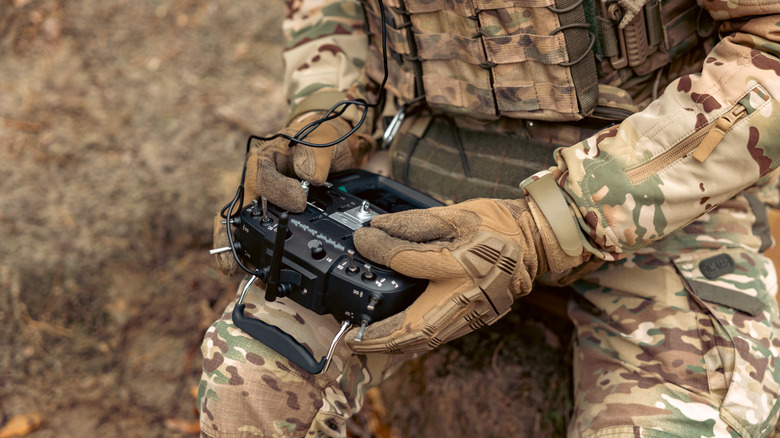5 High-Tech Military Gadgets Used By Special Operations Troops
We may receive a commission on purchases made from links.
Whether it's a hostage rescue or deep reconnaissance, special operations troops are built to handle diverse mission requirements. They represent the elite tip of the spear of any military branch, supported by cutting-edge technology and funding more robust than that of regular forces. Make no mistake, the gear wielded by these revered troops is formidable and expensive, but Hollywood films have often exaggerated their sophistication into science fiction.
Names like the U.S. Army Delta Force and the much-vaunted U.S. Navy Seals easily come to mind (thanks to Hollywood, again), but they aren't the only ones brimming with shiny high-tech hardware. Britain's Special Air Service (SAS), Russia's Spetsnaz, and Israel's Sayeret Matkal are among the world's best-known elite formations, and they use specialized tools designed with precision, stealth, and survivability to achieve their aims. With that said, here are five high-tech military gadgets used by these special operations troops.
Joint Threat Warning Systems
Urban areas are generally considered the most dangerous terrain for an offensive or counterinsurgency force to operate. Densely packed high-rises offer cover to the defenders who can easily slip in and out. To counter that, U.S. Marine Forces Special Operations Command (MARSOC) fields a man-portable slice of the larger SIGINT/EW (signals intelligence and electronic warfare) package, the Joint Threat Warning System.
Designed to operate at the tactical level and small enough to ride on a Marine's back, the system scans across the very-high-frequency (VHF) and ultra-high-frequency (UHF) bands, zeroing in on the transmissions' bearing and location in real time. In other words, the operator can not only eavesdrop on radio signals, but he can also tell where they are coming from via a tablet-style map display. Think of them as a Marine unit's digital and radio eyes of the battlespace.
The system also comes equipped with Low Probability of Detection/Interception (LPD/LPI) waveforms and other emission-control techniques to effectively shrug off counter-interception.
Silent Mortars
Engineers at Russia's Burevestnik Institute sought to "silence" loud mortars and came up with the 2B25 Gull. This 30-pound gun equips the Russian Army's special forces (known as "Spetsnaz") and fires rounds as silent as a Kalashnikov AK-47 rifle with a sound suppressor. In the world of mortars, this is equivalent to whisper-quiet.
It's not the mortar itself that does the trick, but the 3VO35 82mm round it fires. This round ditches the traditional propelling charges in favor of a self-contained cartridge with a piston at the end of its long tail assembly. In practical terms, when a 2B25 releases its high-explosive payload, it does so without a bang, smoke, or muzzle flash.
There's a trade-off, of course: range. Because its cartridge is self-contained, the 2B25 produces less propellant gas to drive the projectile. In other words, it doesn't go very far. The U.S. Army's current lightweight mortar of choice, the 60mm M224, and even the World War II-era Soviet M-37 82mm mortar, can fire over 2 miles. Meanwhile, the 2B25 goes just 0.7 miles. Regardless, trading range for stealth isn't an unfair compromise, especially considering most targets engaged by the Spetznaz would be within close range.
Smart Sights
Sometimes, in the heat of combat, the first shot is all that matters. And what better way for U.S. Marines and special ops teams of the Israeli Defense Forces to do that than by a sophisticated targeting system? Enter the SMARTSHOOTER, SMASH 2000, an Israeli system that precisely acquires targets for the user and can trigger the shot at the right instant.
Smart targeting systems have been around for some time, but what the SMASH 2000 brings to the table is unprecedented full fire control and autonomous tracking for small arms. The system has three parts: an optical sighting system, a special pistol grip, and a pressure button, all of which are attached to a rifle — in the U.S. Special Operations Joint Task Force's case, a M4A1 carbine. The optical sighting system does much of the heavy lifting, with its camera and laser range finder, backed up by onboard computing systems, calculating the precise aim point regardless of the shooter's body movements.
Amid the current proliferation of quadcopters and unmanned aerial vehicles (UAVs) on the battlefield, SMASH 2000-equipped guns also find use as counter-drone systems. The SMASH 2000 isn't yet a U.S. Army-wide weapon, with only the special forces belonging to the Special Operations Joint Task Force-Operation Inherent Resolve (SOJTF-OIR) in Syria being spotted with the system in combat. However, the Army has a long-standing interest in both advanced optics and counter-drone systems, and the SMASH 2000 is making good on it.
Bone Phones
Silence and stealth are key to special operations. Reveal your position, and the enemy knows where you are and can engage accordingly. An advanced communications device originally developed for civilian use, bone-conducting headphones allow special forces to operate without breaking this golden rule.
The science behind bone conduction hearing involves taking a simple shortcut: bypassing the outer ear canal and eardrum and sending vibrations directly to the cochlea via the skull bone. This helps hearing-impaired users who can't pick up sound waves through the ear canal as effectively as everyone else. They are also excellent tools underwater since they use vibrations instead of sound waves.
U.S. Navy Seals have since adapted this innovation for tactical use, pairing bone-conduction earpieces with microphones intentionally strapped to the throat to intercept vibrations from the larynx. It's a combination that allows wearers to communicate more discreetly in an unsafe environment — say, a building crawling with hostiles — while listening for ambient sounds. These systems are typically linked to encrypted radios such as the AN/PRC-148 MBITR to form a compact, low-signature communication setup optimized for stealth.
Nano or Pocket drones
The aptly-named Black Hornet nano UAV is the featherweight champion of the ISR (Intelligence, Surveillance and Reconnaissance) world. That's because while it can fly over 1.2 miles and last for half an hour, at just 7 inches long and weighing 70 grams (for the newer Black Hornet 4), it is small and nimble enough to fit into a soldier's pocket or slip through windows unnoticed.
Officially marketed as the "Personal Reconnaissance System" by developer FLIR (and fielded by the U.S. Army as the "Soldier Borne Sensor"), the Black Hornet takes the form of a helicopter with overhead and tail rotors. It navigates via a direct radio link and satellite-linked control; when GPS or comms are jammed, certain variants can switch to vision-based navigation or simply scurry back toward the operator. Onboard thermal imaging and electro-optical cameras mean there's no hiding in the dark when a Black Hornet's about. Its small size also means reduced noise: don't expect the tell-tale auditory signature of quadcopters.
Those attributes make the Black Hornet exceptionally well-suited to modern, close-in drone reconnaissance. It has been battle-tested as a tactical recon platform by British and American special forces in Afghanistan and has seen use with Ukrainian Special Operations Forces. A typical unit — two drones, a docking station, a handheld touchscreen, and a controller — costs almost $200,000.





